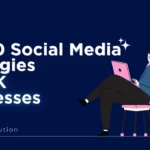
- October 29, 2024
- IRASolutions
- 0
The Emergence of Visual Search in the Digital Age
Visual search defines the situation where the users search using images with the help of AI and machine learning. This is well illustrated by Google Lens, where users use their phones to capture images and search for similar pictures or products. Other examples include the Pinterest lens and the amazon visual search to identify and buy objects online.
The significant distinction between the normal web-based search and the visual search has to do with the exerted input. While in TBS, users enter search queries in the form of a set of keywords, in VS, users submit an image as input.
This technology deploys artificial intelligence to analyze images qualitatively as it returns information on shapes, colors, and patterns of images and hence is well suited for image search.
What is Visual Search?
Visual search is the process by which AI and machine learning algorithms process an image before returning information related to images with similar attributes, such as shape, color, or texture. While conventional search is based on textual queries, visual search is driven by images, changing how people interact with the search tools.
For instance, Google Lens lets you upload an image or take a new one of a landmark, product, or plant, and, in the blink of an eye, you receive descriptions of it. Likewise, Pinterest Lens allows users to search for images, products, or ideas associated with a particular picture the device contains. In retail, companies like Amazon have incorporated visual search into their operations and design to enable the customers to look up products that resemble the images the customer photographs or uploads.
The primary difference between textual and graphical searches lies in the query for the result set. The traditional process can only be done with keywords, while the results of the visual look are based on the ability to recognize objects, patterns, and various visual signs. Changing the search technology used is more friendly, interactive, and graphical for the user than the previous type.
The Growing Popularity of Visual Search
Visual search is still in its early stages and is experiencing increasing growth, with the utilization rates increasing within many sectors. New research shows that within the next two years, three-quarters of the younger generation will prefer visual search to the regular search procedure.
Incorporating internet-based image recognition into augmented reality applications is made smoother and more convenient by various firms such as Google Lens, Pinterest, and Amazon.
Google Lens: Gets more than one billion visual searches monthly, helping people recognize plants, buildings, or landmarks and search for similar clothes based on just one picture.
Pinterest Lens: It serves over 600 million visual searches per month, combining inspiration and products through images.
Amazon: Includes an innovative visual search tool that allows users to find similar products by scanning or uploading photos of the desired product.
Visual search has also been proven to improve consumer participation in electronic commerce. People prefer image-based search results, especially regarding clothing, home décor, and technology products. This indicates that with time, as more users employ visual search, business organizations are likely to search for ways to enhance the use of their websites as a channel for this search behavior.
Importance of image-driven queries in 2024
Leveraging images as search phrases is one of the main trends affecting the sphere of SEO today. Earlier, SEO techniques were mostly based on effective website text and keywords, while visually, there is a new major branch of SEO named Visual SEO.
With a continued advance in artificial intelligence, search engine results are more and more likely to recognize visual data, which gives a fighting chance to sites that focus on image SEO.
Using information retrieved from the Internet, when users make a visual search, the search engines use attributes such as alt text, file names, and metadata to identify the context and relevance of images. Bearing this in mind, image-inclined searches do not work with keywords, and therefore, every web page should have relevant images optimized for appearing in searches.
In contrast to traditional keyword queries, VSLC relies heavily on the quality and relevance of the image and its context. This makes image-driven SEO different from classical SEO because search engines consider not only the words but also the images on the site to return the correct search results.
Optimizing Your Website for Visual Search
Yet, achieving a superb result while utilizing visual search requires further enhancement of your website’s visual materials. Below are some best practices to enhance your site’s visual search SEO performance:
Alt Text: As much as titles describe the image, search engines depend on alt text to interpret the message conveyed in the picture. Always write unique and specific alt-tags to all images on your web page to increase the relevancy of keywords.
File Names: The filename should be meaningful and in correspondence with the incorporated image. It is better to name files like ‘IMG1234.jpg’ instead of using a name that can describe what is on the picture, like ‘blue-leather-sofa.jpg.’
Image Size: Optimize images so that the page loads quickly but does not compromise quality. This enhances user experience and optimizes the company’s position in the foreign market regarding SEO.
Structured Data: Use highly structured data (schema markup), so search engine crawlers can easily understand your visually rich content.
Image Sitemaps: An image sitemap enables search engines to crawl through all images on the site quickly, thus increasing the site’s visibility if someone searches for specific images.
When you achieve the following, you will be featured in the image search results since you need visuals to work for you.
Key Tools for Visual Search Optimization in 2024
The ability to adopt improved tools for the visual search must be employed if a business is to stand out in 2024. Some of the top tools include:
Google Vision AI: By constructing a tool that enables the analysis of images and tagging images by the content within the image, businesses will find it easier to SEO the images.
Pinterest Lens: It assists brands in grasping how their products are being searched visually so that they can improve their content much better.
Yoast SEO: Well known for its wide-ranging SEO capabilities, Yoast also has functionality for optimizing images and other visual content for better SEO.
AI and machine learning are critical when optimizing the visual search process. These tools are useful in enhancing image recognition and tagging results in business so that users can easily find related images.
E-Commerce and Visual Search: Revolutionizing Product Discovery
Visual search also adds a new dimension to how e-shoppers browse products and choose online. Still, with image-based queries, a consumer can take a picture of the product he likes and receive a similar or the exact product. This technology is useful in the fashion, interior decorating, and electronics industries because visuals play a crucial role in decision-making.
That visual search presents a chance for retailers to improve product discovery and ultimately increase sales. Retailers ought to make their visual content as SEO-friendly as possible so that many customers can view it and thus increase the conversion rate. Many businesses that have adopted this technology have testified that they get up to a 30% boost in conversion rates since image-based search warrants a customer a result within no time.
Visual Search and Mobile SEO: The Perfect Match
Thanks to mobile devices and various gadgets, it has become much easier to run a visual search to find products, landmarks, and information in general. As most mobile devices possess camera facilities today, users tend to perform visual searches more often. A majority of visual search queries are performed on mobile devices, and for this reason, m-SEO remains mandatory and crucial for businesses.
To capitalize on this trend, businesses must adopt mobile-first strategies, such as:
Responsive web design, for example, employs images that can change size as per the screens they are displayed across.
Reducing image size as a way of enhancing their performances on mobile devices. One of its key strategic objectives is a mobile-friendly design to address this gap in user experience.
The following strategies will help make the images, videos, and infographics easily visible to mobile users, increase the website ranking on search engine sites, and improve the SEO results.
The Future of Visual Search in SEO
The advancements made in visual search are indicating that the improvements are set to continue in the future. Some new trends include, for example, augmented reality delivery, which allows users to interact with a product before buying it online. Further, the increased reliance on artificial intelligence and machine learning concepts will offer enhanced and more precise search vision.
This means that in the future years, visual search will be an even more central aspect of SEO plans. Since search engines improve the processing and ranking of images and videos, every business will have to pay attention to optimizing the images, videos, and other forms of content used in marketing.
Conclusion: Why Visual Search is the Next Big Thing in SEO
Visual search is becoming one of the most prominent trends in SEO due to the growth of image-based queries and visually oriented-content. Any company that combines visual search SEO and makes considerable efforts to optimize websites for image-based searches will stay ahead of the pack in 2024 and the years to come.
With sites like Google Vision AI and Pinterest Lens and the high emphasis on responsive SEO, it can be safely said that visual search will completely transform how consumers find products online. The search experience is shifting to visual, leaving many businesses questioning the future of search and how they can capture it.





